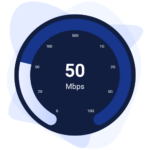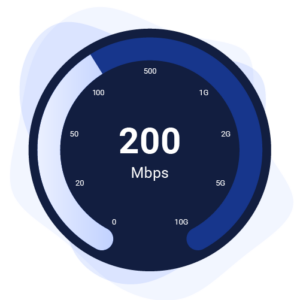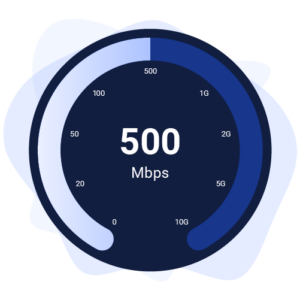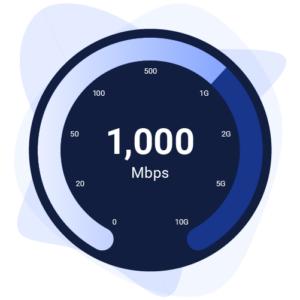Best internet providers for students
-
Best for availability
- No modem fee
- Discounts on mobile plans
-
Best for cable speed
- Wide plan selection
- Cool perks
-
Best for fiber prices
- Unlimited data
- Cheap fiber plans
Data as of 3/10/2025. Offers and availability may vary by location and are subject to change.
Spectrum offers the Internet Advantage plan with speeds up to 100Mbps for households eligible for the Affordable Connectivity Program. It costs $30 per month for 12 months, but customers are reimbursed by the program’s $30 monthly credit, making this internet service free.
If you need mobile service, the Internet Premier plan with Advanced WiFi includes one line of Unlimited Mobile starting at $50 per month for 12 months.
Xfinity is one of the largest cable internet providers in the U.S. It offers exclusive deals to students attending specific colleges and universities. Xfinity makes it easy to find student offers and has a much wider selection than most other ISPs.
If you’re an on-campus student, Xfinity on Campus is exclusive to dorms and other on-campus housing.
Frontier offers something for every kind of student, from grad students to homeschooled K-12 kids.
Frontier gives you a lot of options. If you need a plan with high upload speeds, it’s got that. If you need Wi-Fi to study on the go, it’s got that. Need a ton of bandwidth to keep all your roommates happy? It’s got that too.
What to look for in a student internet plan
While cost is often a major factor, make sure your chosen plan meets your educational needs. In the face of tight deadlines, a reliable internet connection is often even more important than a fast connection.
Many factors determine reliability, from disruptions that impact certain kinds of connections to the responsiveness of internet service providers (ISPs) when networks go down. Even so, speed is still important—especially if you’re sharing an internet plan with roommates.
An excellent first step in finding the right balance for your internet connection is identifying how you plan to use it.
What’s a good internet speed?

- Works best for 1–4 people
- Can check email, browse, make video calls
- Streaming video on one device
- Available on subsidized internet plans

- Works best for 5–7 people
- Good for downloading large files
- HD streaming on multiple devices
- Typically costs around $30/mo.

- Works best for 8–10 people
- Good for downloading large files fast
- 4K streaming on multiple devices
- Typically costs around $50/mo.

- Works best for 10+ people
- Can easily perform most online tasks
- Can handle as much streaming as you want
- Typically costs around $70/mo.
Are there any free internet options for students?
Government programs like the Lifeline program can help low-income families cover their internet bills. The program doesn’t offer free internet, but it can cover some or all of your monthly internet bill costs when combined with other offers from ISPs. Read our guide to government programs for internet assistance to find out more.
Several companies offer completely free internet plans, such as NetZero and FreedomPop. The plans aren’t particularly fast, so while they might do in a pinch, they’re probably not a long-term solution for getting through your undergrad.
T-Mobile introduced Project 10Million in 2020, providing free internet and a hotspot for households eligible for the National School Lunch Program or a similar government program. Students can use 100GB of data annually for five years without paying a dime. Parents can purchase an Android tablet, Windows laptop, or Chromebook through T-Mobile at a discount.
If you’re motivated, there are more ambitious ways of getting around your internet bill, such as constructing a community mesh network. Fortunately, college is an excellent place to make some innovative friends who can pitch in and help.
For more ideas, read our in-depth guide on how to get free internet.
Student internet FAQ
Are you looking up information for an assignment or cramming for a test? Fortunately, even long nights full of web surfing don’t require a lot of speed or data. Web pages with text and images only have no issues on a 1Mbps connection. But if you watch a lot of videos, you’ll probably want download speeds closer to 5–25Mbps.
You will need a reliable connection to watch lectures online. Streaming video can use a lot of download bandwidth, and you’ll need a decent upload speed to participate in the discussion. Software like Microsoft Teams or Zoom will drop your call if your internet speed doesn’t meet the minimum speed requirement.
For example, Zoom can still run on a relatively slow connection, maintaining a 1080p video stream on just 2.5Mbps. But your call could drop if your speed falls below that threshold. A broadband connection usually doesn’t have this problem, but connections with high latency, like satellite internet, might have issues.
If available, use the voice-only option to improve your performance issues.
Cable and DSL internet connections can give you fast download speeds but don’t prioritize upload speeds the same way. Slow upload speeds are usually not a problem for tasks like web surfing or video streaming. But if you frequently upload large files, get a fiber connection with equal upload and download speeds.
Depending on what you study, the connection speed you need for schoolwork could vary wildly. You can get by on a 1Mbps connection if most of your assignments are papers, but you might want a faster plan if you’re in a field like computer science and need to check and recheck a large codebase. A 10Mbps upload speed can make this an easy process.
If you study something like video production, uploading your big project could take all night, as even some faster types of internet, like cable, often have low upload speeds. Although you can get by with less speed, this can be very frustrating, so we suggest an upload speed of at least 25Mbps.